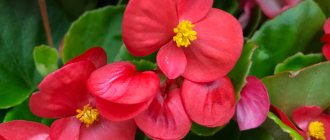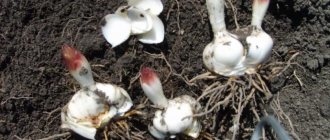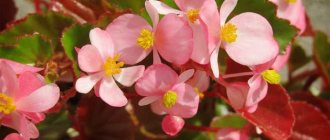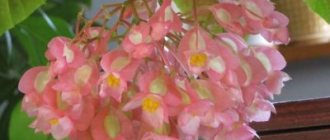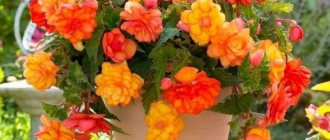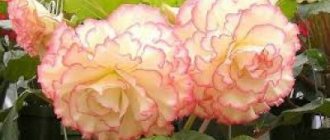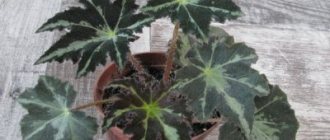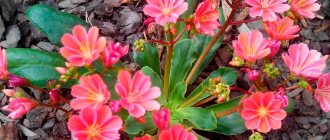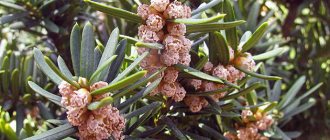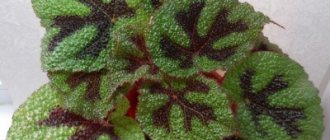Photo of begonia in a pot Ever-flowering begonia (Begonia semperflorens) is a beautiful flowering plant from the Begoniaceae family. In the wild, it is found in the highlands and humid tropics of Africa, America, and Asia. The birthplace of evergreen begonia is Brazil. Here, on the ocean coasts and in forests, the flower develops intensively throughout the year. In countries with temperate climates, the plant is grown indoors.
The plant is a perennial plant that requires periodic rejuvenation. The bushes quickly grow up to 50 cm and manage to bloom in the year of planting. True to its name, the plant blooms all year round, forming simple or double flowers, the delicate petals of which amaze the imagination with a variety of colors.
| It grows very quickly. It can double in size in a year. |
| Blooms in summer, spring and autumn. Blooms already in the first year after planting |
| Easy to grow. There are some minor difficulties |
| Needs rejuvenation as it grows. |
Useful properties of Begonia everblooming
Ever-flowering begonia is not only a beautiful plant, but also useful. Flower cells secrete phytoncides that have a detrimental effect on pathogenic microorganisms in the airspace. Volatile compounds completely neutralize staphylococcus, and reduce the overall concentration of harmful bacteria by almost 80%. Thanks to these properties, the flower increases performance and strengthens the immune system.
Characteristics of a houseplant
Begonia everblooming is a herbaceous perennial with decorative flowers.
- Plant type: begonia.
- Flower color: white, red, crimson, blue, orange, yellow, pink.
- Leaf color: green.
- Sun requirement: sun.
- Size: medium.
- Flowering: blooms in the warm season, for several months.
- Aroma: medium.
Begonia evergreen is a beautiful plant that will delight every owner with its beauty and aroma. This is a great gift for any holiday. Thanks to flowering lasting several months, this bush will perfectly decorate your home or garden.
Basic rules of care. Briefly
Favorable circumstances for ever-flowering begonia at home are:
| Temperature | In winter – no less than + 16° C, in summer – from + 23 – 25° C. |
| Air humidity | Increased; cannot be sprayed; placed on a tray with moistened pebbles. |
| Lighting | Diffused bright; Place on windows facing southwest and southeast. |
| Watering | In summer - once a week; in winter – once every 10 days; do not allow water to stagnate. |
| Priming | A special substrate for begonias or a soil mixture of peat, perlite, leaf soil (2: 1: 2). |
| Feeding and fertilizer | 2 times every 30 days concentrated universal fertilizer for indoor flowers, diluted 2 times. |
| Transfer | Young bushes - annually, in early spring; mature - when the roots completely engulf the earthen ball. |
| Reproduction | By dividing rhizomes, cuttings, seeds. |
| Features of cultivation | In summer, it is recommended to place the flower in a shady place in the garden. |
The peculiarities of growing evergreen begonia should be taken into account. The plant loves fresh air, the room needs to be ventilated more often (but the flower should be protected from drafts). To ensure that the bushes do not stretch out and look compact and fluffy, begonias are pruned. The top is shortened for the first time when the ever-flowering begonia reaches 8 cm. When the side branches grow, they also need to be cut off.
Planting and transplanting
Typically, a soil substrate for indoor plants with a neutral or slightly acidic pH reaction is used - 5.5 - 6.5. You can make the mixture yourself by combining equal parts of garden soil and coarse sand.
The pot chosen is wide and shallow, 15–20 cm high, because the roots of begonia are superficial. Drainage material is placed at the bottom of the container, in a layer of 2–4 cm, to prevent stagnation of water. The soil is poured and compacted to a level of 1 cm below the edge of the watering pot.
As it grows, the plant is transferred to a large container. This method is called transshipment. In this case, the earthen lump is preserved; it is sprinkled with an additional portion of soil.
Important! Transplantation is accompanied by the removal of old leaves.
Caring for Begonia evergreen at home
has adapted perfectly at home Caring for it is simple, although some properties of the plant need to be paid special attention.
Begonia everblooming in bloom
The plant blooms in early May and blooms until November frosts. The flowering of Begonia evergreen is a very attractive phenomenon.
Against the background of glossy green leaves covered with a light fluff, double and simple flowers stand out as bright spots. Their color is varied, represented by all shades of white, yellow, red and their combinations. The duration and splendor of flowering are due to good lighting, high humidity and warmth.
To prolong flowering, faded leaves and inflorescences must be removed immediately.
Temperature
In order for evergreen begonia to bloom beautifully and be healthy, care at home requires observing the temperature regime. This is especially important in winter, when laying flower buds. The thermometer in winter should not fall below + 16° C. In summer, evergreen begonia develops well at temperatures from + 23 - 25° C. With a sharp change in temperature, the flower will drop its buds.
Spraying
Begonia everblooming prefers high humidity. But the plant cannot be sprayed: drops of water leave unsightly stains on the leaves. Only the air space around the flower is sprayed. Begonia is placed on a tray with moistened pebbles, and air humidifiers are used.
Lighting
Begonia everblooming prefers diffused bright light. It is an indispensable guarantee of lush flowering and a beautiful exterior of the plant. It is preferable to place the flower on a window facing the southwest or southeast side. On the south side, shading is necessary on hot sunny days: aggressive sun can cause leaf burn.
Begonia evergreen needs good lighting up to 15 hours a day. In winter and autumn it is necessary to turn on the backlight.
Watering
Watering plays an important role in plant care. Domestic ever-blooming Begonia likes the soil to be moderately moist, and not too dry or flooded. Water the plant along the edge of the pot, avoiding the leaves and flowers. In summer, water once every 7 days.
In winter - once every 10 days. Does not tolerate stagnant moisture. Therefore they provide good drainage. Use lukewarm, settled water. Watering with cold water or excess moisture leads to root rot.
Begonia pot
Ever-flowering begonia has a poorly developed root system. Its roots are located superficially. Therefore, a pot for begonias needs to be wide, but not deep. This is especially true for small, recently rooted bushes . They are first planted in small pots, the diameter of which is no more than 6 cm. In a container with a larger diameter, the root system may rot, and the begonia will not bloom. To prevent stagnation of moisture, there should be several drainage holes at the bottom.
Soil for Begonia everblooming
The substrate for the plant is required to be loose, water- and breathable. Its important characteristics are fertility, low acidity and lightness. The soil for Evergreen Begonia can be prepared yourself from two parts of leaf soil and peat and part of perlite. Stores sell soil mixture for begonias. The composition of the mixture can be improved with vermiculite, crushed moss and humus.
Feeding and fertilizer
To maintain beautiful flowering and strengthen the vitality of the plant, fertilizing and fertilizing are important. At a time that does not coincide with the dormant period, ever-flowering begonia at home should receive concentrated fertilizer for flowering plants, diluted by half, twice every 30 days.
It is necessary to ensure that the nitrogen content in the fertilizer does not exceed the content of potassium and phosphorus, otherwise this will have a bad effect on flowering.
Transfer
The flower is replanted in early spring. Transplantation is carried out when the roots cover the entire earthen ball.
Young bushes are replanted more often than mature ones. For adults, the top layer of soil is refreshed. The flower is transferred from the old container and the roots are examined. Rotten roots are shortened, the remaining ones are dipped in a solution of potassium permanganate for 20 minutes. After this, the roots are dried and the plant is replanted. After transplantation, the ever-flowering begonia should be kept in a shaded place for several days. After a week they begin to water it, and after 3 weeks they begin to feed it.
Dormant period of Begonia everblooming
When conditions in the environment differ from those that are optimal for the plant, the dormant period of Begonia everblooming begins. In winter, this time coincides with shorter daylight hours and lower temperatures. In summer, the flower stops developing when the thermometer rises above + 27° C.
The ever-flowering begonia stops growing and blooming and directs all its energy to moving nutrients from the leaves and stem to the roots. Therefore, pruning of green and elastic shoots is not carried out.
Growing begonia from seeds
Begonia evergreen seedlings
Begonia evergreens are grown through seedlings. It is useless to sow directly into open ground; there will be no seedlings. Begonia seeds are tiny, but coated seeds are sold in coated coatings; they are larger and more convenient to plant. Buy seeds in stores; you do not need to collect seeds from growing bushes, they may not reproduce the quality of the mother plant.
Buy special soil for begonias and pour it into a shallow container. If you're planting in small batches, disposable plastic containers with lids work great. Moisten the soil with a spray bottle with warm water; there is no need to make it too wet. Make shallow grooves and, using the wet tip of a toothpick, place the seeds at a distance of 1.5-2 cm from each other. Spray thoroughly until the colored shell of the dragee dissolves and cover with a transparent lid, cling film or glass. This way you will create greenhouse conditions. Write the name of the variety on each container.
Important! Begonia seeds are not sprinkled with soil; they germinate in the light.
We place our crops in a warm (+20-24 degrees), bright place, but not in direct sunlight. Additional illumination with phyto lamps or fluorescent lamps is mandatory. Within 2-3 weeks the first shoots will appear. They will be very small, but don’t be scared, they will grow into excellent bushes. You can carefully add soil to the seedlings from the edges of the furrows. This will give stability to the “kids”. Seedlings do not like waterlogging, so remove condensation from the lid.
You need to water the sprouts little by little, only when the soil on top dries out. It is convenient to do this using a pipette or syringe. Seedlings begin to be fed after the first true leaves appear. Complex fertilizer for flower seedlings will be sufficient.
Grown up begonia seedlings
After 3-4 leaves appear, the seedlings can be planted in separate pots. This must be done carefully so as not to damage the plant.
Begonia blooms 4-6 months after germination. The optimal time to sow seeds is December-February, earlier in the southern regions, later in the northern regions.
The time for sowing seedlings depends on the climate of a particular region and what age of seedlings you want to plant on the site.
Reproduction
Begonia evergreen can be propagated in different ways:
- By cuttings. In spring and summer, stem cuttings 10 cm long and having 3 pairs of leaves are cut. They are planted in the ground, deepening to the first bud. Cover with film and root at + 25° C, regularly ventilating and watering. After a month, the plants are transplanted into small pots.
- Leaf plate: the leaf is planted in moist soil and placed in a film with lower heating. The seedling is watered and ventilated. After rooting, they are planted in small containers.
- Seeds. At the end of winter, small begonia seeds are laid out on the ground, sprayed and covered with film, removing it to ventilate and water. After 14 days, sprouts will appear. After the formation of 3 leaves, the seedlings dive.
When propagating begonias with double flowers, only vegetative propagation is used.
Pruning begonias for the winter
Fertilizer and feeding of begonias
To form flowers, the plant needs nutrition. At the moment of bud formation (and this happens throughout the growing season), mineral and organic nutritional compositions are added. Fertilize the plant every 2 weeks.
Rules for applying fertilizing:
- At optimal temperatures (18-22°), food is absorbed much better.
- Nutrient compositions are applied in the evening, after moistening the soil in the flowerbed.
- It is necessary to water at the root, but without the solution touching the plant.
Important! Despite the fact that ever-flowering begonia loves food, you should never overfeed it. Excess nutrition leads to the death of the tropical guest.
Special preparations are used to fertilize begonias:
- “Begonia” will help provide you with potassium and phosphorus, macroelements and microcomponents.
- “Bona Forte for begonias” will help the plant adapt to negative external environmental factors.
- “Good Power” will fill it with nitrogen, phosphorus and other useful components for abundant flowering.
Proper nutrition will help the plant gain strength and produce a large number of buds. With regular dosed fertilizer, flowering continues throughout the growing season.
Advice! Begonia responds gratefully to the addition of 2 g of boric acid and 1 g of manganese. The products are diluted in 10 liters of water and watered the flowerbed.
Diseases and pests
When the rules of care are violated, diseases appear and pests attack the weakened plant. Most often, begonia problems manifest themselves as follows:
- evergreen begonia leaves fall
- leaves wither - moisture deficiency (adjust watering);
- weak flowering - poor lighting, nutrient deficiency (move to a bright place, turn on the backlight; feed);
- leaves are dry and limp - high temperature and low air humidity (place on a tray with wet expanded clay, spray the air around the plant);
- the leaves of the evergreen begonia turn yellow - high humidity at low temperatures (adjust watering, replant the flower, put it in a warmer place);
- small white spots on begonia leaves – powdery mildew (use fungicide);
- black and brown spots on the leaves - infection with the fungus botrytis (fungicides are used);
- rot on the leaves - spraying from above (spray only the air around the plant; if the process is at the very beginning, remove damaged leaves and stop spraying; if most of the plant is affected, it cannot be saved, healthy cuttings are rooted).
Begonia everblooming can be affected by thrips, scale insects and whiteflies. Insects are treated with insecticides.
Signs of trouble
The leaves turn pale, the shoots stretch out - the result of insufficient lighting, especially in winter. It is necessary to ensure optimal light conditions and organize additional lighting during short daylight hours.
The intensity of flowering decreases due to excess bright light and excessive air humidity. The plant needs shading and ventilation.
The edges of the leaves turn brown and dry - dry air and overheating. Exposure to direct sunlight should be limited and the air humidified.
The buds are falling, the flower buds are drying - low air humidity. It needs to be moisturized additionally.
Begonia drops flowers - this happens with a sharp change in temperature and humidity; can be observed in a recently acquired or suddenly moved specimen - as a stress reaction that passes as it adapts to new conditions, if they meet the needs of the plant.
Leaves and stems turn black - usually in frostbitten specimens grown in open ground. Select undamaged, strong bushes, transplant them into pots and transfer them to a warm room.
Popular varieties of evergreen begonia
Begonia everblooming is one of the favorite plants of breeders. Many varieties adapted to temperate climate conditions have been developed; they are cultivated in home plantings. Several varieties are the most popular.
Begonia "Lotto"
Begonia "Lotto" is a tall, compact bush. The leaves are velvety, bright emerald. Large flowers can be painted in different colors.
Begonia "Senator"
Begonia "Senator" is a medium-sized bush with bronze leaves. Medium-sized flowers can have different colors.
Begonia "Ambassador"
Begonia "Ambassador" is a compact, medium-sized bush. Green leaves with bright red edges. The flowers are monochrome (white, red or pink) or bicolor.
Begonia "Queen"
Begonia "Queen" - low-growing bushes with bright green leaves and double flowers of carmine, pink or snow-white color.
Begonia "Cocktail"
Begonia "Cocktail" is a low-growing, lush-flowering bush. Leaves are brownish-red. The flowers are painted in scarlet, white, pink tones.
Varieties and photos
Numerous varieties of everflowering begonia (more than 900 in total) can be divided into several groups. According to the height of the trunk: tall, medium-sized and short . Below are descriptions and photos of evergreen begonia varieties suitable for propagation, planting and care at home.
Begonia was first described in 1690 by biologist Michel Begon, whose surname, in fact, has remained in the name of the culture ever since. However, the plant gained its popularity only 200 years later, in 1815-1817. The crop began to be exported from the Antilles, the Hindustan Peninsula and Brazil, and hybrid varieties were actively developed and put up for sale.
Tall ones rarely exceed 40 cm and more often stop at 30. They have large rounded leaves and flowers with a diameter of 5-6 cm. They grow well indoors, but in the summer the crop can be planted in an outdoor flower garden and kept there until the first frost.
A striking representative of the group: the annual Alba, with which landscape designers love to decorate ridges and flower beds . It can also be grown at home, but given the annual growth of the trunk by 40-50 cm, it will have to be replaced every year. The bush is spreading, with dense leaves covered with a light waxy coating. The buds are collected in brushes of 12-14 pieces, white.
Another example that looks great both in a single copy and in a group is Katie Teicher. It also takes root in a pot on a windowsill, in open ground. Loves warmth, but tolerates winter well. The veiny bright green leaves and lush scarlet inflorescences catch the eye. The Boushin variety also belongs to the tall variety.
Medium-sized ones stretch up to 20-25 cm in height, have smaller leaves and modest flowers. They take root both on the street and in the house, but the plant should be renewed every 2 years (otherwise you will not get a flower pleasing to the eye, but a half-naked vine). A bright example - the Carmen variety - is used to decorate alpine hills and flower beds in the middle zone. The leaves are dark brown, smooth, the flowers are pale pink (collected in inflorescences of 6 pieces). Other medium-growing varieties: Mix F1, Havana Scarlet, Othello.
Low-growing varieties - from 8 to 18 cm in height. The flowers are collected in clusters, the leaves are small. They adapt well and grow when propagated by cuttings, and store-bought seeds allow you to obtain a pure variety. They look good in hanging flowerpots on loggias, balconies and winter gardens. One of the dwarf varieties - Albert Martin - does not exceed the 15 cm mark , but this is also rare. Used for finishing flower beds and borders, it will become a highlight of the home flower garden. The leaves are bright emerald with a scarlet border along the edges, the flowers are a spectacular carmine color, growing in inflorescences of 6-8 pieces.
The Bella variety looks very elegant: a miniature bush with greenish leaves decorated with a red border, in the midst of which pale pink flowers with yellow cores are visible. We especially love landscape designers who use evergreen begonia to create group plantings in gardens. Other low-growing varieties: Bikola, Lucenec F1, Olomouc.
Photo of evergreen begonia flowers growing in open ground:
Photo of evergreen begonia in a pot:
How to preserve young tubers
It is recommended to store young begonia tubers in winter in pots filled with moistened soil. Place several nodules in a pot and moisten the soil as it dries.
How to store begonia in winter:
- in the basement - at a temperature of 10 degrees and air humidity of at least 80%. “Adult” specimens will also overwinter here. They are placed in a box with a layer of sand and peat at the bottom. The tubers should not touch each other. The top of the “masonry” is covered with a storage mixture - vermiculite;
- in the refrigerator - dried tubers are placed in a bag with peat and vermiculite, holes are made for air; or packaged in a food container as for storage in the basement. Dryness of the filling mixture is the main condition for storing tubers;
- in an apartment - put the pot in a cool, dark and damp room, or place it near the balcony door, or store it on an insulated balcony; You should not move the pot from place to place and check the root system. How to preserve ampelous begonia in winter? Ampel varieties of begonias belong to the tuberous species and are stored as indicated above.
